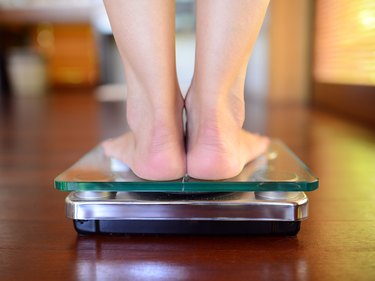
You likely already know that having overweight is linked to a higher risk of heart disease, certain cancers and myriad other conditions. And you know that BMI, or body mass index, is the best measure of whether you have overweight — right?
For years, BMI has been the gold standard for determining whether your weight falls in a healthy range. The formula is your weight in kilograms divided by the square of your height in meters (this can be hard to figure out on your own, but you can calculate it here.)
Video of the Day
Video of the Day
But more recently, research has suggested that where you store your weight may be just as important as how much you weigh (if not more so). A July 2019 study of more than 155,000 postmenopausal women in JAMA Network Open found that those with a normal BMI (between 18.5 and 24.9) whose waist circumference was over 35 inches were almost a third more likely to die from cancer or heart disease than those with smaller waists who were also at a healthy weight.
(A quick note that the study authors used the term "postmenopausal women," so we've included that here. We typically aim to use more inclusive language when possible.)
"A BMI can give us important health information, but it's not a perfect indicator — our research indicates that what's deep within your abdominal area is just as, if not more, important," study co-author Wei Bao, MD, PhD, an epidemiologist in the College of Public Health at the University of Iowa in Iowa City, tells LIVESTRONG.com.
In other words, how much belly fat you have may be a better health indicator than your overall body mass index or weight.
Why Is Belly Fat So Toxic?
It's actually not your muffin top itself that's dangerous. "This type of stomach fat is known as subcutaneous fat, since it's right underneath your skin," explains Pamela Peeke, MD, MPH, an assistant professor of medicine at the University of Maryland and author of Body for Life for Women.
Subcutaneous or "soft" belly fat is no more dangerous than the fat on your arms or thighs.
The real villain, Dr. Peeke says, is visceral or "hard" fat, aka the stuff that pads your internal organs. This type of fat is more metabolically active, which means it causes your body to secrete stress hormones like cortisol that in turn increase your blood pressure and blood sugar, raising your risk for a whole slew of diseases.
"You can get a very accurate idea of whether or not you're in the healthy zone by looking at all three measures — your BMI, your waist circumference and your waist-to-hip-ratio."
The Best Way to Measure Body Fat
The best way to tell how much visceral fat you have is to have a CT or MRI scan done on your abdominal area, says Dr. Bao. But that's expensive. An easier option is simply to grab a tape measure and check your waist circumference.
Waist Circumference
Using a cloth measuring tape, measure your waist at your belly button. (Make sure the tape's parallel to the ground.) An ideal, healthy measurement for women is below 35 inches, and below 40 inches is the aim for men, says Dr. Bao.
Waist-to-Hip Ratio
If you're borderline, it's a good idea to also calculate your waist-to-hip ratio: Measure your waist at your belly button and your hips at their widest point, then divide your waist size by your hip size. A healthy waist-to-hip ratio is under 0.9 for men and under 0.8 for women, according to the National Center for Biotechnology Information.
While there are other ways to measure your body fat, like using skinfold calipers, these aren't always accurate and can be pricey.
The solution? "You can get a very accurate idea of whether or not you're in the healthy zone by looking at all three measures — your BMI, your waist circumference and your waist-to-hip-ratio," says Dr. Bao.
3 Ways to Blast Belly Fat
The good news is that belly fat responds well to a mix of healthy eating and exercise. Here, three small changes that can help you trim down your waistline, stat.
1. Time Your Eating
Dr. Peeke advises her patients to eat all their daily calories within a 12-hour window — usually between 7 a.m. and 7 p.m. This type of eating pattern — known as time-restricted eating or intermittent fasting — can help reduce levels of visceral fat, according to a June 2014 paper in Nutrition Research Reviews.
It also prevents late-at-night noshing, which is another risk factor for developing visceral fat, adds Dr. Peeke.
2. Nix the Nightcap
If you can't put a kibosh on alcohol entirely, limit it to an occasional treat. An August 2017 Korean study in Public Health Nutrition found a link between boozing it up and abdominal obesity.
"Alcohol raises your body's insulin levels, which in turn encourages it to store fat around your abdomen," explains Dr. Peeke. "It also loosens your inhibitions, making it more likely you'll eat everything that's not tacked down."
3. Take Your Workout Up a Notch
High-intensity interval training (HIIT) — bursts of all-out exercise with short breaks in between — has been shown to be much more effective at getting rid of visceral fat than regular, moderate activity, notes Dr. Peeke.
Indeed, a February 2018 review in Sports Medicine looked at 39 studies and concluded that HIIT significantly reduced both total and abdominal body fat.
Try to incorporate it into your cardio activity for about 20 minutes twice a week. "It's easy to do — if you walk, for example, then do a five-minute warm-up, then 30 to 60 seconds at a much higher pace or walking uphill, bring it back down for a minute, then ramp it right back up again for 30 to 60 seconds," recommends Dr. Peeke.
- JAMA Network Open: "Association of Normal Weight Central Obesity With All-Cause and Cause-Specific Mortality Among Postmenopausal Women"
- Nutrition Research Reviews: "Physiological responses to food intake throughout the day"
- Public Health Nutrition: "Relationship between abdominal obesity and alcohol drinking pattern in normal-weight, middle-aged adults: the Korea National Health and Nutrition Examination Survey 2008-2013"
- National Center for Biotechnology Information: "Waist-Hip Ratio"
- Sports Medicine: "Effect of High-Intensity Interval Training on Total, Abdominal and Visceral Fat Mass: A Meta-Analysis"


